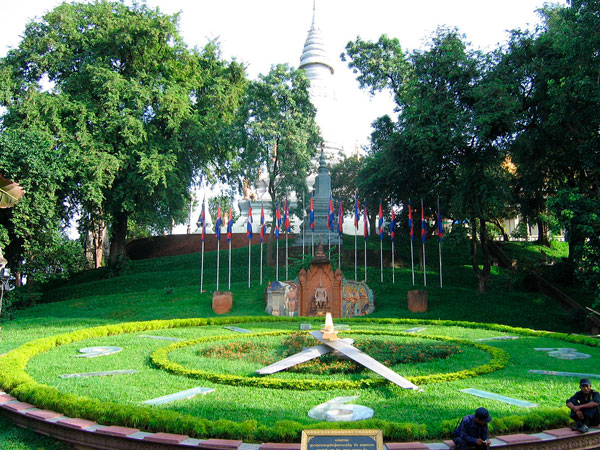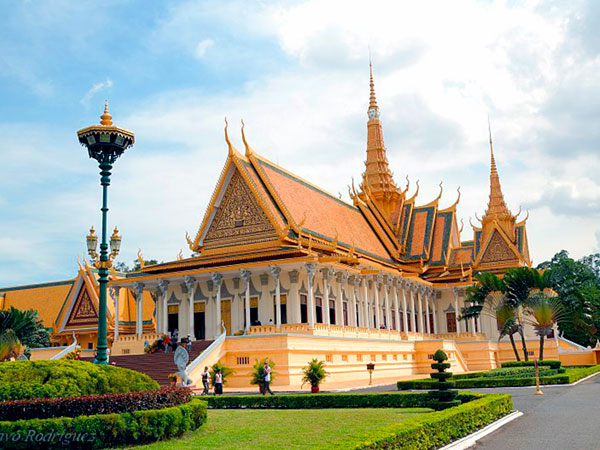Opening Hours: Daily 08:00 - 17:00
Address: Preah Ang Eng Street (13), Phnom Penh
Tel: +855 23 217 643
The National Museum of Cambodia is the country’s largest archeological and cultural history museum. It enables you to have a glimpse into the cultural side of Cambodian history dating back to the 4th century. Inaugurated in 1920 as the Musée Albert Sarraut during the French colonial period, its opening was initiated by George Groslier – a famed author and historian – and architect as well as the first curator of the museum.
In 1951, the French conceded the control of the museum to the Cambodians when it came be known as Musée National de Phnom Penh. Later in 1966, Chea Thay Seng became the museum’s first Cambodian director. It barely survived serious damage during the devastating Khmer Rouge regime from 1975 to 1979, and the museum and its precincts underwent a major refurbishment in the 1990s with contributions from the Australian Government and other patrons.
Backed by the Cambodian Department of Museums, the museum’s role is now not just confined to preserving its exhibits that include one of the largest collections of Khmer artifacts in the world, but also to oversee other museums in the country.
National Museum of Cambodia Highlights
Housed within an impressive red sandstone structure, The National Museum of Cambodia stands out as a fine illustration of the traditional Khmer architecture. With over 14,000 interesting exhibits to its credit, the museum is truly a treasure trove of artifacts portraying Khmer or Angkorian culture and history.
Its exhibits comprising bronze/wood sculptures, ceramic items, ethnographic items and stone articles are categorized into four brackets: prehistoric, pre-Angkor, Angkor and post-Angkor exhibits. One of its most spectacular exhibits is the eight-armed statue of Lord Vishnu that dates back to the 6th century. Another remarkable attraction is the image of King Jayavarman VII in a meditation posture that can be seen in the West Gallery displaying art works from Angkor Wat.
Visit the museum’s Bronze Gallery to take a peep into bronze-casting methods practiced during the Angkorian period from the 6th to 13th centuries. Found next to the Bronze Gallery is a rare repository of post-Angkorian era Buddha images. There is also a gallery that exhibits a selection of sandstone sculptures dating back to the 6th century.
Good to Know about National Museum of Arts
Located a few blocks away from the Royal Palace on Street 13 in Phnom Penh, the museum is open from 08:00 to 17:00. Admission charge is nominal and entry is free for children and school groups. The museum does not permit photography within the galleries. However, visitors are allowed to take pictures of the courtyard and exterior.
The services of French and English speaking guides are available. Alternatively, you can purchase a booklet that provides relevant info on locations of the museum’s most prominent exhibits. Items such as postcards, replica sculptures and books on art and culture can be bought from the store found at the main entrance.
The museum is equally noteworthy for its impeccable, verdant garden courtyard with four lotus pools. In the centre of the courtyards is a renowned statue of the Leper King or Lord Yama – the Deity of Death according to Hindu mythology. Further, the porticos that bound the garden courtyard is notable for its stone works, bas reliefs, ornamental door lintels and significant stele containing old Khmer as well as Sanskrit inscriptions – most dating from between the 6th and 11th centuries.
Adjacent to the museum is the Royal University of Fine Arts whose origins trace back to the École des Arts Cambodgiens that was founded in 1918 under the supervision of George Groslier to train students in the art of bronze casting, traditional drawing, furniture making and sculpture modeling, which is still continued here.












